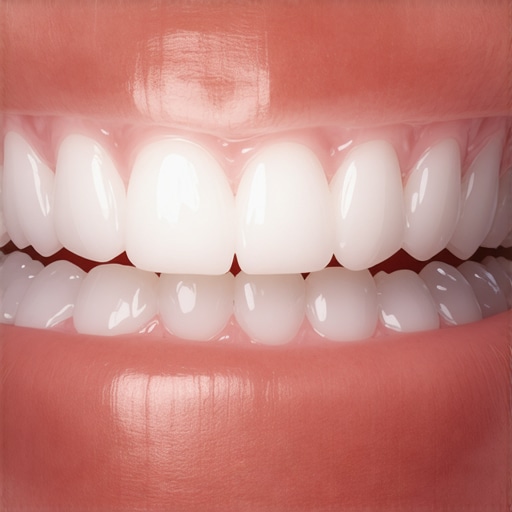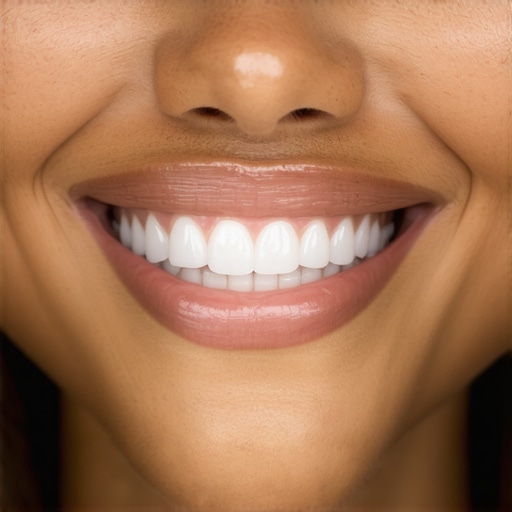Understanding the Synergistic Role of Veneers and Invisalign in Contemporary Smile Makeovers
In the realm of advanced aesthetic dentistry, the integration of veneers and Invisalign represents a paradigm shift, offering patients bespoke solutions that marry functionality with artistry. As we approach 2024, it is crucial for practitioners to deepen their understanding of how these modalities can be combined to optimize outcomes, especially considering the nuanced biomechanics and material science involved.
Delving into the Material Science and Biomechanical Interplay
High-quality porcelain veneers exhibit remarkable translucency and durability, yet their success hinges on meticulous preparation and bonding techniques. Conversely, Invisalign’s clear aligners leverage precise digital workflows and biomechanical principles to facilitate orthodontic movements with minimal invasiveness. The intersection of these technologies demands an expert comprehension of occlusal dynamics and soft tissue interactions, ensuring that the final aesthetic result harmonizes with functional integrity.
Advanced Considerations in Treatment Planning and Case Selection
Expert clinicians recognize that not all cases are suitable for combined veneer and Invisalign therapy. Critical evaluation involves assessing enamel thickness, periodontal health, and the patient’s occlusal scheme. For instance, cases requiring significant vertical dimension restoration benefit from a phased approach—initial orthodontic alignment via Invisalign, followed by veneer placement to refine aesthetics. This strategic sequencing minimizes risks such as veneer debonding or occlusal trauma.
What are the latest innovations in adhesive dentistry that enhance veneer bonding longevity in complex cases?
Recent advancements include the development of universal adhesives and nanohybrid resin composites that improve bond strengths and resistance to marginal leakage. Incorporating these materials into practice, alongside digital smile design, elevates predictability and patient satisfaction. For an in-depth review, consult the Journal of Esthetic and Restorative Dentistry.
To stay at the forefront, practitioners should continuously explore interdisciplinary techniques, integrating digital workflows for precise case planning. Engage with comprehensive resources such as Veneers Made Simple to refine your mastery and contribute insights from your clinical experiences.
As the aesthetic and functional demands evolve, the mastery of combined veneer and Invisalign treatments will distinguish leading practices, delivering transformative results that resonate with the discerning patient demographic of 2024 and beyond.
Are We Seeing the Next Frontier in Cosmetic Dentistry with Veneers and Invisalign?
As technology advances, the integration of veneers and Invisalign is becoming more sophisticated, enabling clinicians to craft smiles that are not only aesthetically stunning but also functionally impeccable. The question for experts today is: how can we leverage emerging innovations to push the boundaries of what’s possible in smile makeovers? From biomimetic materials to digital treatment planning, the future holds exciting potential for personalized, minimally invasive solutions that meet diverse patient needs.
Exploring Cutting-Edge Materials and Techniques for Superior Bonding and Durability
Recent breakthroughs in adhesive dentistry are revolutionizing veneer longevity, especially in complex cases that demand high resilience. Nanostructured adhesives and bioactive resin composites now offer enhanced bonding strength, reduced marginal leakage, and improved resistance to wear. These materials, when combined with digital smile design and CAD/CAM fabrication, facilitate precise, predictable outcomes. For practitioners committed to excellence, staying abreast of these innovations is essential—consider consulting sources like the Journal of Esthetic and Restorative Dentistry for in-depth research on advanced adhesive systems.
How can understanding biomechanical principles and material science optimize the longevity of combined veneer and Invisalign treatments?
Integrating biomechanical insights with advanced materials allows clinicians to craft more resilient restorations. For example, understanding occlusal load distribution helps in selecting appropriate veneer thicknesses and placement strategies, minimizing risks of chipping or debonding. Moreover, digital workflows enable precise planning of orthodontic movements to harmonize with restorative designs, reducing undue stress on veneers.
For a comprehensive approach, explore Invisalign and Teeth Whitening: Your Complete Smile Makeover Guide to integrate orthodontics seamlessly into your aesthetic plans.
Personalized Smile Design: From Digital Planning to Patient Satisfaction
The evolution of digital smile design tools now allows for highly personalized treatment planning. By simulating various veneer shapes, shades, and alignments before the actual procedure, clinicians can set accurate expectations and enhance patient satisfaction. Combining this with Invisalign’s precision orthodontics creates a synergistic effect, leading to harmonious, natural-looking results. Implementing these techniques requires an understanding of both digital tools and artistic principles—resources like Veneers Made Simple offer valuable insights into mastering this process.

What are the ethical considerations and potential pitfalls when adopting these advanced techniques in your practice?
While cutting-edge technologies promise excellent outcomes, they also demand a commitment to ethical practice, including transparency about treatment limitations, costs, and expected results. Over-reliance on digital simulations without clinical validation can lead to unrealistic patient expectations. Maintaining a balance between innovation and patient-centered care is vital—consider reviewing privacy policies and ethical guidelines to ensure responsible practice.
If you’re eager to elevate your aesthetic dentistry skills, share your thoughts below or explore more about creating confident, beautiful smiles at Contact Us. Your journey toward mastering modern smile makeovers begins with continuous learning and innovation.
Harnessing the Power of Biomimetic Materials to Extend Veneer Durability in Complex Cases
As the frontier of aesthetic dentistry advances, the application of biomimetic materials is revolutionizing how clinicians approach veneer longevity and resilience. Biomimetic materials emulate natural tissue properties, facilitating restorations that integrate seamlessly with biological structures. For instance, bioactive glass composites not only bond effectively but also promote remineralization of adjacent enamel, reducing the risk of secondary caries and marginal failure. These innovative materials, when paired with precise digital planning, enable practitioners to craft restorations that withstand functional stresses over extended periods, even in cases with challenging occlusal dynamics.
The Critical Role of Occlusal Force Distribution in Enhancing Longevity
Understanding the biomechanics of occlusal force distribution is paramount in designing durable veneer and Invisalign combined therapies. Excessive or uneven forces can lead to veneer chipping, debonding, or accelerated wear. Advanced finite element analysis (FEA) models allow clinicians to simulate occlusal load patterns, optimizing veneer thickness and placement to mitigate stress concentrations. Incorporating such biomechanical insights ensures restorations are not only aesthetically pleasing but also resilient under functional demands, especially in patients with parafunctional habits like bruxism.
How can digital biomechanics simulations predict and prevent potential failure modes in combined veneer and Invisalign treatments?
Digital biomechanics simulations utilize FEA to model patient-specific occlusal forces and material behaviors, providing a predictive map of stress distribution across restorations. These simulations help identify potential failure points before clinical execution, enabling preemptive adjustments such as modifying veneer thickness, adjusting occlusal contacts, or incorporating protective appliances. The integration of this technology elevates treatment planning from reactive to proactive, reducing the incidence of post-treatment complications and enhancing overall longevity. For further insights, see the Journal of Biomechanics in Dentistry.
Embracing these innovations requires a multidisciplinary mindset—merging material science, digital technology, and clinical expertise. As you refine your approach, consider investing in advanced simulation software and staying current with emerging research to push the boundaries of what is achievable in smile rehabilitation. Your continued pursuit of knowledge not only benefits your practice but also elevates patient outcomes to new heights.
Unlocking the Potential of Customized Occlusal Schemes for Enhanced Restoration Durability
In the pursuit of longevity and functional harmony, the integration of tailored occlusal schemes becomes a cornerstone in combined veneer and Invisalign treatments. By meticulously analyzing each patient’s unique occlusal dynamics through digital occlusal analysis tools, clinicians can develop bespoke strategies that distribute forces optimally across restorations, thus minimizing stress concentrations and preventing premature failure. This approach not only enhances veneer lifespan but also safeguards the temporomandibular joint and soft tissues from undue strain.
How Can High-Performance Biomaterials Elevate Clinical Outcomes in Complex Cases?
Recent developments in biomaterials, such as bioactive glass composites and hybrid nanoceramics, have revolutionized restorative dentistry by offering superior bond strength, enhanced wear resistance, and biological integration. These materials emulate natural tissue properties, promoting remineralization and reducing secondary caries risk. When integrated with advanced digital workflows, they enable the fabrication of restorations with unparalleled precision and durability, especially critical in patients with parafunctional habits or significant occlusal challenges. For authoritative insights, see the Journal of Esthetic and Restorative Dentistry.
What are the implications of leveraging AI-driven predictive analytics in treatment planning?
Artificial intelligence (AI) is increasingly pivotal in predicting treatment outcomes by analyzing vast datasets of clinical cases, material behaviors, and biomechanical simulations. AI-driven predictive analytics facilitate the creation of highly personalized treatment protocols, foreseeing potential failure modes and optimizing intervention sequences. This foresight enables practitioners to refine veneer thickness, aligner design, and occlusal adjustments proactively, thereby elevating success rates and patient satisfaction. Embracing this technology represents the frontier of precision aesthetic dentistry.

How Does Digital Twin Technology Transform Long-Term Prognosis of Smile Makeovers?
The advent of digital twin technology allows for the virtual modeling of a patient’s oral environment, including occlusal forces, soft tissue responses, and material interactions over time. By simulating various scenarios, clinicians can anticipate how restorations will withstand functional stresses and biological changes, leading to more resilient designs. This proactive approach not only prolongs veneer and aligner longevity but also enhances the predictability of aesthetic results across the patient’s lifespan. For further exploration, consult Nature Scientific Reports on Digital Twins in Dentistry.
Engage with Cutting-Edge Knowledge to Elevate Your Practice
Staying ahead in aesthetic and functional dentistry necessitates continuous education and adaptation of emerging technologies. By integrating advanced biomaterials, AI analytics, and digital twin simulations into your clinical workflow, you can craft highly durable, personalized smile restorations that stand the test of time. To deepen your mastery, participate in specialized courses, attend industry conferences, and collaborate with interdisciplinary teams dedicated to innovation in dental science. Your proactive pursuit of knowledge will set your practice apart as a leader in advanced smile design.
Expert Insights & Advanced Considerations
1. Embrace Interdisciplinary Integration
Combining veneer technology with digital orthodontics like Invisalign requires a comprehensive understanding of biomechanics, material science, and digital planning. Specialists who master this integration can craft long-lasting, aesthetically superior results that are tailored to complex cases, pushing the boundaries of traditional aesthetic dentistry.
2. Prioritize Material Innovation
Latest advancements in nanohybrid resins and bioactive materials significantly enhance bonding strength and durability of veneers, especially in cases with high functional demands. Staying updated with these innovations ensures optimal longevity and patient satisfaction in advanced smile makeovers.
3. Leverage Digital Twin and AI Technologies
Digital twin models and AI-driven analytics are transforming treatment planning by predicting long-term outcomes and customizing force distribution. These tools enable clinicians to preempt potential failures and optimize restorations, elevating the standard of care in aesthetic dentistry.
4. Focus on Personalized Occlusal Schemes
Developing bespoke occlusal strategies based on digital analysis minimizes undue stress on veneers and orthodontic appliances. This precision approach enhances the functional lifespan of combined treatments and reduces complications such as veneer debonding or occlusal trauma.
5. Commit to Ethical and Patient-Centered Practice
Emerging technologies must be integrated responsibly, with transparency regarding limitations and realistic outcomes. Maintaining ethical standards ensures trust and sustains professional credibility in delivering cutting-edge smile makeovers.
Curated Expert Resources
- Journal of Esthetic and Restorative Dentistry: Offers peer-reviewed research on the latest adhesive innovations and biomimetic materials that enhance veneer bonding and durability.
- Invisalign Innovation in 2025: Highlights advancements in digital orthodontic solutions, integrating clear aligners with restorative procedures for seamless aesthetics and function.
- Nature Scientific Reports on Digital Twins in Dentistry: Provides insights into how virtual modeling predicts long-term treatment success and guides personalized restorative strategies.
- SmileGumCare’s Veneers Made Simple: A comprehensive resource for mastering digital smile design and integrating it with advanced material applications in clinical practice.
- ScienceDirect on Biomechanical Analysis: Features cutting-edge studies on finite element analysis and its application in optimizing veneer placement and occlusal force distribution.
Final Expert Perspective
The integration of veneers and Invisalign in 2024 exemplifies the pinnacle of modern aesthetic dentistry, where innovation, precision, and ethical practice converge. By harnessing emerging materials, digital technologies, and biomechanical insights, expert clinicians can deliver transformative smiles that stand the test of time. Staying at the forefront of these advances requires continuous learning, interdisciplinary collaboration, and a commitment to excellence. Engage with ongoing research, participate in specialized training, and share your insights to elevate the standards of smile makeovers—your expertise shapes the future of aesthetic dentistry.

